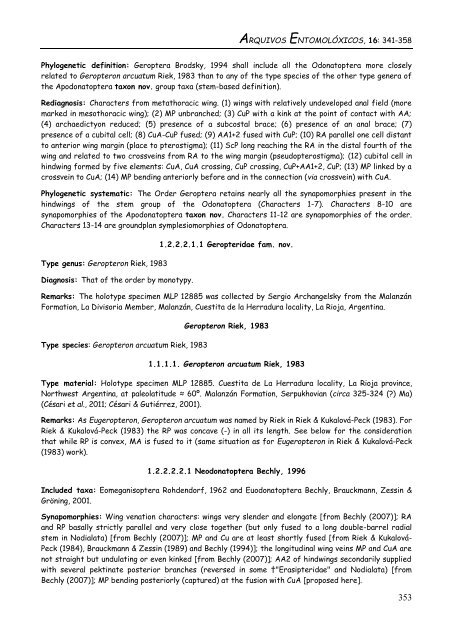ARQUIVOS ENTOMOLÓXICOS ARTIGO / ARTÍCULO / ARTICLE
ae16_2016_petrulevicius_gutierrez_new_basal_odonatoptera_lower_carboniferous_argentina
ae16_2016_petrulevicius_gutierrez_new_basal_odonatoptera_lower_carboniferous_argentina
You also want an ePaper? Increase the reach of your titles
YUMPU automatically turns print PDFs into web optimized ePapers that Google loves.
<strong>ARQUIVOS</strong> <strong>ENTOMOLÓXICOS</strong>, 16: 341-358<br />
Phylogenetic definition: Geroptera Brodsky, 1994 shall include all the Odonatoptera more closely<br />
related to Geropteron arcuatum Riek, 1983 than to any of the type species of the other type genera of<br />
the Apodonatoptera taxon nov. group taxa (stem-based definition).<br />
Rediagnosis: Characters from metathoracic wing. (1) wings with relatively undeveloped anal field (more<br />
marked in mesothoracic wing); (2) MP unbranched; (3) CuP with a kink at the point of contact with AA;<br />
(4) archaedictyon reduced; (5) presence of a subcostal brace; (6) presence of an anal brace; (7)<br />
presence of a cubital cell; (8) CuA-CuP fused; (9) AA1+2 fused with CuP; (10) RA parallel one cell distant<br />
to anterior wing margin (place to pterostigma); (11) ScP long reaching the RA in the distal fourth of the<br />
wing and related to two crossveins from RA to the wing margin (pseudopterostigma); (12) cubital cell in<br />
hindwing formed by five elements: CuA, CuA crossing, CuP crossing, CuP+AA1+2, CuP; (13) MP linked by a<br />
crossvein to CuA; (14) MP bending anteriorly before and in the connection (via crossvein) with CuA.<br />
Phylogenetic systematic: The Order Geroptera retains nearly all the synapomorphies present in the<br />
hindwings of the stem group of the Odonatoptera (Characters 1-7). Characters 8-10 are<br />
synapomorphies of the Apodonatoptera taxon nov. Characters 11-12 are synapomorphies of the order.<br />
Characters 13-14 are groundplan symplesiomorphies of Odonatoptera.<br />
Type genus: Geropteron Riek, 1983<br />
Diagnosis: That of the order by monotypy.<br />
1.2.2.2.1.1 Geropteridae fam. nov.<br />
Remarks: The holotype specimen MLP 12885 was collected by Sergio Archangelsky from the Malanzán<br />
Formation, La Divisoria Member, Malanzán, Cuestita de la Herradura locality, La Rioja, Argentina.<br />
Type species: Geropteron arcuatum Riek, 1983<br />
Geropteron Riek, 1983<br />
1.1.1.1. Geropteron arcuatum Riek, 1983<br />
Type material: Holotype specimen MLP 12885. Cuestita de La Herradura locality, La Rioja province,<br />
Northwest Argentina, at paleolatitude ≈ 60º. Malanzán Formation, Serpukhovian (circa 325-324 (?) Ma)<br />
(Césari et al., 2011; Césari & Gutiérrez, 2001).<br />
Remarks: As Eugeropteron, Geropteron arcuatum was named by Riek in Riek & Kukalová-Peck (1983). For<br />
Riek & Kukalová-Peck (1983) the RP was concave (-) in all its length. See below for the consideration<br />
that while RP is convex, MA is fused to it (same situation as for Eugeropteron in Riek & Kukalová-Peck<br />
(1983) work).<br />
1.2.2.2.2.1 Neodonatoptera Bechly, 1996<br />
Included taxa: Eomeganisoptera Rohdendorf, 1962 and Euodonatoptera Bechly, Brauckmann, Zessin &<br />
Gröning, 2001.<br />
Synapomorphies: Wing venation characters: wings very slender and elongate [from Bechly (2007)]; RA<br />
and RP basally strictly parallel and very close together (but only fused to a long double-barrel radial<br />
stem in Nodialata) [from Bechly (2007)]; MP and Cu are at least shortly fused [from Riek & Kukalová-<br />
Peck (1984), Brauckmann & Zessin (1989) and Bechly (1994)]; the longitudinal wing veins MP and CuA are<br />
not straight but undulating or even kinked [from Bechly (2007)]; AA2 of hindwings secondarily supplied<br />
with several pektinate posterior branches (reversed in some †"Erasipteridae" and Nodialata) [from<br />
Bechly (2007)]; MP bending posteriorly (captured) at the fusion with CuA [proposed here].<br />
353


